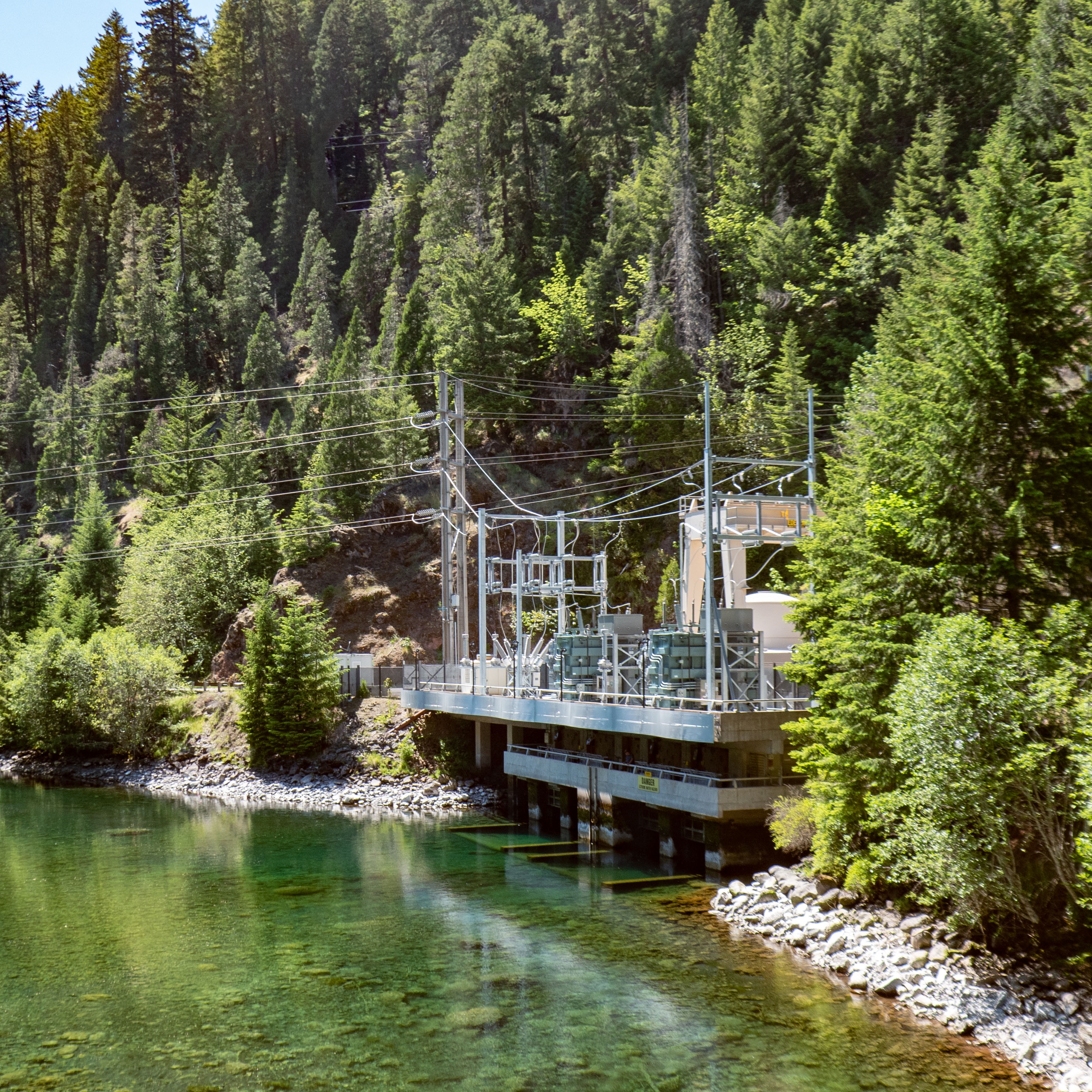Related News
Related News
-
Energy shortfall of 9 gigawatts projected for the Northwest
By 2030, a dry year combined with soaring energy demand during extended cold snaps could lead to rolling blackouts, a new study warns.
Find Out More -
Sustainability Snapshot - Celebrating Energy Efficiency Projects in the Community
Sustainability Snapshops highlight impactful projects completed by EWEB's Customer Solutions department, as a way to celebrate the meaningful work happening behind the scenes.
Find Out More -
EWEB secures $2.5 billion of reliable, affordable, carbon-free energy for customers
The new contract with EWEB’s largest energy supplier, the Bonneville Power Administration, forms the foundation of a diverse energy portfolio.
Find Out More -
Women in STEM: Meet the Hydro Project Engineer Building Habitat for Salmon
EWEB Engineer Associate Val Chang found her way to the McKenzie River from Los Angeles, inspired by heritage trips to the waters of Taiwan and key mentors along the way.
Find Out More -
Public Power Week Poster Contest Winners 2025
The results are in! View the winning posters from EWEB's 2025 Public Power Week Poster Contest.
Find Out More -
EWEB Hometown Heroes compete internationally
Out of 290 teams from 14 different countries, EWEB's Lineman Rodeo team places in the top third of competitors.
Find Out More -
Vote for your favorite Public Power Week Posters
The top five submittals will receive awards. Help us pick the winners.
Find Out More -
Electric Projects underway in North & South Eugene
Underground lines and disaster-resilient power poles are part of EWEB’s infrastructure upgrade near Eugene’s largest natural resource area.
Find Out More -
The Bonneville Power Administration Rate Change and Your EWEB Bill
BPA’s finalized rate increase is smaller than projected, and EWEB’s pass-through adjustment effective October 1, 2025 will now be 2.7% for residential customers—down from the anticipated 4%.
Find Out More -
EWEB completes helicopter installation of salmon habitat features
EWEB adds downed trees and 2,000 tons of gravel to the Uupper McKenzie River below Tamolitch Falls to improve spawning habitat.
Find Out More -
Court rules in favor of EWEB in Carmen-Smith litigation
The U.S. District Court in Eugene has granted EWEB's motion to dismiss a lawsuit brought under the Endangered Species Act pertaining to fish passage at EWEB’s Trail Bridge Dam. The favorable ruling clears the way for EWEB to continue advancing towards implementation of permanent fish passage at the dam.
Find Out More -
EWEB proposes modified plan for permanent fish passage at Trail Bridge Dam
After eight months of extensive collaboration and analysis with scientific experts at two federal regulatory agencies, EWEB is proposing an improved plan to build permanent fish passage facilities at Trail Bridge Dam on the McKenzie River.
Find Out More -
Sustainability Snapshot - Ideal Steel July 2025
Our second Sustainability Snapshop highlights a project where EWEB helped a local industrial warehouse upgrade over 1,000 flourescent lights to new efficient LEDs.
Find Out More -
EWEB prepares for wildfire season with risk mitigation measures
EWEB is building a more resilient electric system to weather various types of disasters, from wildfire to winter storms.
Find Out More -
EWEB, Lane County host open house to gather feedback for “Leaburg Transportation Alternatives Analysis”
“What is the Future of the Leaburg Dam Bridge?” open house exhibit on display at Lloyd Knox Park Visitor Pavilion through July 25
Find Out More - Show More
EWEB publishes first draft of roadmap to Eugene’s reliable, affordable and clean energy future
December 14, 2022

EWEB is developing a plan to ensure that Eugene has a sufficient supply of reliable, affordable and clean electricity in the decades ahead, and is inviting the community to participate in the process.
This week, EWEB announced the release of the initial public draft of the plan, which is called an Integrated Resource Plan (IRP). The IRP forecasts EWEB’s electricity needs 20 years into the future and uses advanced modeling software to suggest which combination of energy resources – such as wind, solar, hydropower or biomass – might best fit those needs.
To create the IRP, EWEB developed a rigorous process that ensures any future portfolio of energy resources is reliable, affordable and clean. A portfolio must provide sufficient electricity during the times of day and seasons of the year when EWEB’s customers need it. A portfolio must be a low-cost option. And a portfolio must continue to be 90% carbon-free, as EWEB’s portfolio currently is, while becoming 95% carbon-free by 2030.
The initial public draft of the IRP is just a starting point. EWEB will continue to analyze energy resource options for the next six months before publishing a final draft of the IRP in June. Beyond that, EWEB will update the plan every two years.
“We know EWEB needs to procure more electricity in the years ahead to meet the growing needs of our customers,” said Megan Capper, EWEB’s energy resources manager. “What we’re doing now is trying to figure out which energy resources are the best fit for EWEB’s needs. Our initial results in this first draft of the IRP suggest one road forward. But we want to know what other options exist, and what the tradeoffs are between options.”
EWEB is encouraging customers to participate in the analysis process by submitting their questions about Eugene’s energy future at eweb.org/IRP. Customers can also sign up to receive regular email updates about the IRP.
The initial public draft of the IRP offers a few key insights:
Demand for electricity will grow. EWEB’s customers are switching from gasoline-powered cars and gas furnaces to electric vehicles and electric heat pumps. Electrification will cause electricity demand to rise. EWEB expects this trend to take off in the 2030s.
Legacy hydropower is a good fit for EWEB’s needs. EWEB has relied on hydropower from the Bonneville Power Administration (BPA) for many decades because it’s a cheap, carbon-free resource that that can be dispatched at a moment’s notice to meet our customer’s demand. Between EWEB-owned projects and BPA, hydropower makes up about 80% of EWEB’s energy supply. Continuing to rely on hydropower is likely a good idea.
Wind and batteries offer a possible path forward. To supplement BPA hydropower, one viable option is for EWEB to build large batteries paired with new wind farms. This makes sense because, here in the Northwest, wind is an abundant renewable resource that, unlike solar energy, generally produces power when EWEB has peak needs. And large utility-scale batteries would help smooth gaps in that power generation.
EWEB needs to develop customer programs responsive to energy needs. By partnering with customers, EWEB can reduce demand for electricity, especially when demand is at its peak. Electricity used during peaks is generally more expensive for EWEB to provide, and it is also associated with higher carbon emissions. Demand response programs and time-of-use rates are two ways EWEB could lower peak demand.
The initial public draft of the IRP charts out one potential portfolio of energy resources – called a “reference case” – that EWEB could pursue during the next 20 years. The reference case is not a preferred portfolio of energy resources. Rather, it is a benchmark that EWEB can build upon to analyze other options in the next six months.
To create the reference case, EWEB analysts first plugged into the modeling software their best-guess assumptions about future conditions – including prices for resources, demand growth, availability of transmission and other factors. Then, they set constraints – most notably that any resource portfolio must be 95% carbon-free by 2030. Lastly, they had the software generate the lowest cost portfolio based on those assumptions and within those constraints. By adjusting the assumptions or constraints, EWEB can generate different potential portfolios.
EWEB analysts already have additional questions they want to answer about the portfolio options. How will low water years and more protective fish regulations influence hydropower generation? Will certain resources be preferable if there is limited transmission to carry energy from far away renewable resources? To what extent will conservation be more affordable than acquiring new resources? And what will happen if EWEB is required to have greater power reserves available?
EWEB is actively seeking public input on the types of questions EWEB should seek to answer before finalizing the IRP in June 2023. Customers can visit eweb.org/IRP to fill out a short comment form with their question.
On the website, community groups, environmental justice organizations and others can also request a meeting during which EWEB will present the findings of the initial draft and have a dialogue.

